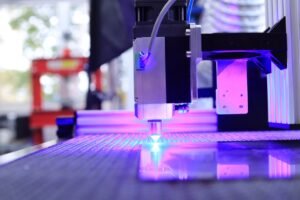Comprehensive Guide of 3D Printing
Overview
3D printing, also known as additive manufacturing, is a revolutionary hobby that involves creating three-dimensional objects from digital files. This process typically uses materials such as plastic, resin, or metal, which are layered to build the final product. Enthusiasts of 3D printing can design their own models using computer-aided design (CAD) software or download pre-made designs from online repositories. This hobby allows individuals to bring their ideas to life, whether it’s creating custom toys, household items, or intricate art pieces. The accessibility of 3D printers has made it a popular choice for makers, hobbyists, and even professionals looking to prototype their designs. Additionally, 3D printing fosters creativity, problem-solving skills, and technical knowledge, making it a fulfilling and educational pastime.
History
The origins of 3D printing can be traced back to the early 1980s when Charles Hull invented stereolithography, the first 3D printing technology, which allowed for the creation of solid objects from liquid resin using ultraviolet light. This groundbreaking innovation laid the foundation for various other 3D printing methods, including fused deposition modeling (FDM) and selective laser sintering (SLS). Over the years, 3D printing technology has evolved significantly, becoming more affordable and accessible to the general public. In the 2000s, the introduction of open-source 3D printers, such as the RepRap project, democratized the technology, allowing hobbyists to build their own printers and share designs. Today, 3D printing is utilized in various industries, including healthcare, aerospace, and automotive, showcasing its versatility and potential for innovation.
Popularity and Demographics
3D printing has gained immense popularity among a diverse range of demographics, appealing to tech enthusiasts, artists, educators, and DIYers alike. According to a report by Statista, the global 3D printing market is expected to reach over $40 billion by 2024, indicating a growing interest in this hobby. Many schools and universities have incorporated 3D printing into their curricula, encouraging students to explore design and engineering concepts. Additionally, online communities and forums dedicated to 3D printing have flourished, providing a platform for enthusiasts to share their projects, seek advice, and collaborate on designs. The rise of social media has also played a significant role in promoting 3D printing, with platforms like Instagram and YouTube showcasing impressive creations and tutorials, further inspiring individuals to take up this innovative hobby.
Sponsored Hobbyists and Vendors
Become a Sponsor!
Affiliate Disclaimer: Throughout some sections below, Hobby Spotlight may suggest some tools, equipment or material using affiliate links. By purchasing any of those items, Hobby Spotlight may earn a small commission. This helps fund our website, content and services without directly charging our users.
Getting Started
3D Printing Essentials:
Beginner
- 3D Printer: Entry-level 3D printer suitable for beginners.
- PLA Filament: Common filament material for 3D printing.
- 3D Printing Software: User-friendly software for designing 3D models.
- Build Surface: Surface for better adhesion during printing.
- Spatula Tool: Tool for removing prints from the build plate.
Intermediate
- Resin Printer: Advanced printer for high-detail prints using resin.
- ABS Filament: Durable filament material for more advanced projects.
- 3D Scanner: Device for scanning objects to create 3D models.
- Upgraded Nozzle Set: Set of nozzles for different printing needs.
- Calipers: Precision measuring tool for accurate dimensions.
Basic Requirements and Initial Setup:
- 3D Printer: A reliable 3D printer is essential. Options range from entry-level models to advanced machines, depending on your budget and needs.
- Filament: The material used for printing, such as PLA, ABS, or PETG. Each type has different properties and applications, so choose based on your project requirements.
- Design Software: Software like Tinkercad, Fusion 360, or Blender is necessary for creating or modifying 3D models before printing.
Fundamental Skills to Learn:
- Model Design: Understanding how to create or modify 3D models is crucial for successful printing.
- Printer Calibration: Learning to calibrate your printer ensures accurate dimensions and quality prints.
- Material Handling: Knowing how to properly store and handle filament can prevent issues like moisture absorption.
- Post-Processing: Techniques such as sanding, painting, or assembling parts after printing enhance the final product.
- Problem Solving: Developing troubleshooting skills for common printing issues like warping or layer separation is essential.
Sub-Hobby/Common Activities:
- Model Creation: Designing custom models for personal use or sharing with the community.
- Upgrades and Modifications: Enhancing existing printer capabilities through hardware upgrades or modifications.
- Community Engagement: Participating in online forums or local maker spaces to share knowledge and collaborate on projects.
- Prototyping: Using 3D printing for rapid prototyping in product design or engineering.
- Artistic Projects: Creating sculptures, jewelry, or decorative items using 3D printing techniques.
Terminology:
- Filament: The material used in 3D printing, available in various types and colors.
- Extruder: The component of a 3D printer that feeds filament into the hot end for melting and deposition.
- Layer Height: The thickness of each printed layer, affecting print quality and speed.
- Infill: The internal structure of a printed object, which can be adjusted for strength and weight.
- Support Structures: Temporary structures printed to support overhangs or complex geometries during printing.
- Slicing Software: Software that converts 3D models into instructions (G-code) for the printer.
- Bed Adhesion: Techniques used to ensure the first layer of a print adheres properly to the print bed.
- Overhang: A part of the model that extends beyond the previous layer, requiring support during printing.
- Print Speed: The rate at which the printer moves while depositing material, affecting print quality and time.
- Calibration: The process of adjusting the printer settings to ensure accurate and high-quality prints.
Advanced Topics and Specializations
Advanced Tools and Equipment:
- High-Precision 3D Printer: A professional-grade 3D printer with advanced features like dual extrusion, high resolution, and large build volume for intricate designs.
- 3D Scanner: A device that captures the physical dimensions of an object and converts it into a digital 3D model for printing or editing.
- Filament Dryer: A specialized dryer that removes moisture from 3D printing filament to prevent printing issues and improve quality.
- Resin Printer: A high-resolution resin printer that uses UV light to cure liquid resin, allowing for detailed and smooth prints.
Advanced Projects and Achievements:
- Custom Prosthetics: Designing and printing personalized prosthetic limbs that enhance mobility and comfort for users.
- Architectural Models: Creating detailed scale models of buildings and structures for presentations and educational purposes.
- Functional Mechanical Parts: Producing intricate gears and components for robotics or machinery that demonstrate precision engineering.
Advanced Techniques and Methods:
- Multi-Material Printing: Utilizing printers that can handle multiple materials simultaneously to create complex, functional objects.
- Post-Processing Techniques: Applying methods such as sanding, painting, or assembling to enhance the finish and functionality of printed items.
- Parametric Design: Using software to create adaptable models that can be easily modified based on specific requirements or constraints.
Specializations and Niche Areas:
- Medical Applications: Focusing on bioprinting and the creation of medical devices tailored to individual patient needs.
- Art and Sculpture: Exploring the artistic side of 3D printing by creating unique sculptures and installations.
- Jewelry Design: Crafting intricate and customizable jewelry pieces using 3D printing technology.
- Educational Tools: Developing teaching aids and models that enhance learning experiences in classrooms.
- Home Decor: Designing and printing personalized home accessories and furniture items that reflect individual style.
Future Trends and Innovations:
- Increased use of sustainable materials, such as biodegradable filaments, in 3D printing.
- Advancements in bioprinting technology for creating tissues and organs for medical research.
- Integration of AI in design software to streamline the modeling process and enhance creativity.
- Expansion of 3D printing in construction, allowing for the rapid building of homes and structures.
- Growth of community-based makerspaces that provide access to 3D printing technology and resources.
Technology Integrations:
- Cloud-Based Design Software: Platforms that allow users to collaborate on 3D models and access tools from anywhere.
- 3D Scanning Technology: Using scanners to create digital models of existing objects for replication or modification.
- Augmented Reality (AR): Implementing AR to visualize 3D models in real-world environments before printing.
- IoT-Enabled Printers: Printers that can be monitored and controlled remotely for enhanced convenience.
- Online Marketplaces: Platforms for sharing and selling 3D printable designs, fostering a global community of creators.
Further Learning and Resources
Books:
- 3D Printing for Dummies by Kalani Kirk Hausman and Richard Horne: An accessible guide that introduces the basics of 3D printing, covering everything from printer setup to design software.
- Getting Started with 3D Printing by Liza Wallach Kloski and Nick Kloski: A practical book that walks beginners through the initial steps of 3D printing, including choosing a printer and creating simple designs.
- 3D Printing: The Next Industrial Revolution by Christopher Barnatt: An overview of how 3D printing is transforming industries, providing insights into its applications and future potential.
- The 3D Printing Handbook by Ben Redwood, Filemon Schoffer, and Brian Garret: A comprehensive resource that delves into advanced 3D printing techniques, materials, and applications for experienced users.
- 3D Printing with Autodesk 123D by John Wargo: An advanced exploration of using Autodesk 123D for creating intricate 3D designs, aimed at users looking to enhance their skills.
Websites:
- Thingiverse, https://www.thingiverse.com – A vast repository of user-created 3D models available for free download and printing.
- MyMiniFactory, https://www.myminifactory.com – A platform for sharing and downloading 3D printable designs, with a focus on quality and community.
- Shapeways, https://www.shapeways.com – An online 3D printing service that allows users to create, customize, and sell their designs.
- Pinshape, https://pinshape.com – A community-driven site for sharing and discovering 3D printable designs, with user ratings and reviews.
- 3D Hubs, https://www.3dhubs.com – A platform connecting users with local 3D printing services, offering a range of materials and technologies.
Courses:
- 3D Printing for Beginners on Udemy, https://www.udemy.com/course/3d-printing-for-beginners – A comprehensive introduction to 3D printing, covering the basics of design and printing.
- Introduction to 3D Printing by Coursera, https://www.coursera.org/learn/3d-printing – A course that explores the fundamentals of 3D printing technology and its applications.
- 3D Modeling and Printing with Tinkercad on Skillshare, https://www.skillshare.com/classes/3D-Modeling-and-Printing-with-Tinkercad/202123123 – Learn to create 3D models using Tinkercad, perfect for beginners.
- Advanced 3D Printing Techniques on LinkedIn Learning, https://www.linkedin.com/learning/advanced-3d-printing-techniques – A course designed for those looking to enhance their 3D printing skills with advanced techniques.
- 3D Printing Specialization by Coursera, https://www.coursera.org/specializations/3d-printing – A series of courses that delve into the design, modeling, and printing processes, suitable for intermediate learners.
Content Creators and Community
Content Creators:
- 3D Printing Nerd (YouTube): A channel dedicated to 3D printing technology, featuring reviews, tutorials, and project ideas for enthusiasts of all levels.
- Maker’s Muse (YouTube): Focuses on 3D printing tips, design tutorials, and product reviews, helping viewers enhance their 3D printing skills.
- CNC Kitchen (YouTube): Offers insights into 3D printing and CNC machining, with practical projects and detailed explanations of techniques.
- 3D Printing (Instagram): A visual platform showcasing innovative 3D printed designs and projects from creators around the world.
- 3D Printing Group (Facebook): A community for sharing tips, projects, and troubleshooting advice among 3D printing enthusiasts.
- 3D Printing on Twitch (Twitch): Live streaming sessions where creators demonstrate 3D printing processes and engage with viewers in real-time.
- Thingiverse (Website): A platform for sharing and downloading 3D printable designs, fostering a community of makers and designers.
Online Forums and Social Media Groups:
- Reddit – /r/3Dprinting: A vibrant community for sharing projects, asking questions, and discussing the latest in 3D printing technology.
- Facebook 3D Printing Groups: Various groups where hobbyists share their prints, tips, and experiences in 3D printing.
- 3D Printing Discord Servers: Interactive platforms for real-time discussions, troubleshooting, and sharing resources among 3D printing enthusiasts.
- Instagram Hashtags (#3DPrinting, #3DPrinted): Follow these hashtags to discover inspiring projects and connect with other creators.
- Pinterest Boards: Explore a variety of 3D printing ideas, designs, and tutorials curated by passionate makers.
Local Clubs and Organizations:
- Makerspaces: Community workshops that provide access to 3D printers and other tools, fostering collaboration and learning.
- Local Tech Clubs: Many cities have clubs focused on technology and making, often including 3D printing as a key component.
- University Maker Labs: Educational institutions often host maker labs open to students and the public, offering resources for 3D printing.
- 3D Printing Meetups: Platforms like Meetup.com host local gatherings for enthusiasts to share knowledge and projects.
- STEM Organizations: Groups that promote science, technology, engineering, and math often include 3D printing in their activities and workshops.
Events, Meetups, and Conventions:
- 3D Print Expo: A major event showcasing the latest in 3D printing technology, featuring workshops, presentations, and networking opportunities.
- Maker Faire: A festival of invention and creativity where 3D printing is prominently featured among various maker projects.
- Local Hackathons: Events where participants collaborate on projects, often including 3D printing as a key element of design and prototyping.
- 3D Printing Workshops: Various organizations host workshops to teach specific skills and techniques related to 3D printing.
- Tech Conferences: Many technology conferences include sessions and exhibits focused on 3D printing innovations and applications.
Associated Hobbies
- Model Making: Many 3D printing enthusiasts enjoy creating detailed models, whether for architecture, vehicles, or characters. This hobby allows for creativity and precision, often leading to impressive displays or functional items.
- Art and Sculpture: Artists can use 3D printing to bring their visions to life, creating intricate sculptures and art pieces that may be difficult to achieve through traditional methods.
- Prototyping: Inventors and entrepreneurs often use 3D printing to create prototypes of their products. This allows for rapid iteration and testing of designs before moving to mass production.
- Jewelry Design: 3D printing has revolutionized jewelry making, enabling designers to create unique and complex pieces that can be customized for individual clients.
- Home Decor: Many hobbyists create decorative items for their homes using 3D printing. This can include vases, wall art, and functional items like lamps and furniture accessories.
- Gaming Miniatures: Tabletop gamers often use 3D printing to create custom miniatures for their games. This allows for personalization and enhances the gaming experience with unique characters and settings.
- Educational Tools: Educators can use 3D printing to create teaching aids and models that enhance learning in subjects like science, math, and history, making complex concepts more tangible.
- Repair and Replacement Parts: 3D printing can be used to create replacement parts for household items, appliances, or even vehicles, providing a cost-effective and sustainable solution for repairs.
Cost and Budgeting
Initial Investment and Ongoing Costs:
- Initial Investment: The cost to start 3D printing can vary significantly based on the type of printer and materials you choose. Entry-level FDM (Fused Deposition Modeling) printers can be purchased for around $200-$500, while more advanced models, such as resin printers, can range from $300 to over $1,500. Additionally, you may need to invest in a computer with suitable software, which can add another $100-$1,000 depending on your needs.
- Ongoing Costs: The primary ongoing costs include filament or resin, which can range from $20 to $50 per kilogram for filament and $30 to $100 per liter for resin. Other costs may include replacement parts for the printer, maintenance supplies, and electricity. If you choose to sell your prints, consider the costs of marketing and shipping as well.
Budget-Friendly Options:
- Entry-Level Printers: Look for budget-friendly 3D printers from brands like Creality or Anycubic, which offer reliable performance at lower price points.
- Filament Discounts: Purchase filament in bulk or during sales to save money. Websites like Amazon and specialty 3D printing stores often have discounts on larger quantities.
- Open-Source Software: Utilize free or open-source software like Cura or Blender for designing and slicing your 3D models, eliminating the need for expensive software licenses.
Where to Buy:
- Local Electronics Stores: Many electronics retailers carry a selection of 3D printers and supplies, allowing you to see the products in person before purchasing.
- Specialty 3D Printing Shops: These stores focus specifically on 3D printing and often provide expert advice, as well as a range of printers and materials.
- Online Retailers: Websites like Amazon, MatterHackers, and 3D Universe offer a wide variety of 3D printers, filaments, and accessories, often with customer reviews to help guide your purchase.
Money Making
How to Turn the Hobby into a Profession or Side Hustle:
- 3D Printing Service Provider: Start a business offering 3D printing services to individuals and companies. You can create custom prototypes, models, or parts for clients in various industries, such as engineering, architecture, and product design. By investing in high-quality printers and materials, you can cater to a diverse clientele and charge for your expertise and time.
- 3D Printed Product Sales: Design and sell your own 3D printed products online. This could include unique home decor items, custom jewelry, or functional tools. Platforms like Etsy or your own e-commerce website can be used to showcase your creations. Focus on niche markets to stand out and attract specific customer bases.
- 3D Printing Education and Workshops: Share your knowledge by offering workshops or online courses on 3D printing. Teach beginners how to use 3D printers, design models using CAD software, and troubleshoot common issues. This can be done in-person or through platforms like Udemy, allowing you to reach a wider audience.
- 3D Modeling and Design Services: If you have skills in 3D modeling software, offer your services to create custom designs for clients. This could involve designing prototypes for inventors, creating models for animation, or developing unique items for businesses. Building a portfolio and networking within relevant industries can help you attract clients.
- 3D Printing for Prototyping: Partner with startups or inventors to provide rapid prototyping services. Many businesses require prototypes to test their ideas before mass production. By offering quick turnaround times and high-quality prints, you can establish long-term relationships with clients looking to bring their products to market.
Benefits and Enjoyment
Physical, Mental, and Social Benefits:
- Physical Activity: Engaging in 3D printing often involves physical tasks such as assembling printers, handling materials, and post-processing prints. This can improve fine motor skills and hand-eye coordination.
- Mental Stimulation: 3D printing requires problem-solving skills, creativity, and technical knowledge. Designing models and troubleshooting printing issues can enhance cognitive abilities and foster innovative thinking.
- Social Connection: The 3D printing community is vibrant and collaborative. Joining forums, attending meetups, or participating in maker fairs allows enthusiasts to share ideas, collaborate on projects, and build friendships with others who share their passion.
Success Stories and Inspirational Examples:
- Bre Pettis: Co-founder of MakerBot, Bre Pettis played a significant role in popularizing 3D printing for consumers. His vision helped bring affordable 3D printers to homes and schools, inspiring countless individuals to explore the technology.
- Joris Laarman: A Dutch designer known for his innovative use of 3D printing in furniture design, Joris Laarman has created stunning pieces that blend art and technology. His work has pushed the boundaries of what is possible with 3D printing, inspiring designers worldwide.
- Formlabs: This company revolutionized the 3D printing industry with its high-quality resin printers. Their success story showcases how a small startup can impact the market, encouraging others to explore 3D printing for professional and personal use.
Ways to Enjoy and Grow in the Hobby:
- Experiment with Different Materials: Explore various filaments and resins to understand their properties and applications. This experimentation can lead to unique creations and enhance your skills as a 3D printing enthusiast.
- Join Online Communities: Participate in forums, social media groups, or local maker spaces to connect with other 3D printing enthusiasts. Sharing experiences, tips, and projects can significantly enhance your knowledge and enjoyment of the hobby.
- Take Online Courses: Many platforms offer courses on 3D modeling and printing techniques. Investing time in learning new skills can help you create more complex designs and improve your overall proficiency in the hobby.
Challenges and Solutions
Common Challenges Faced by Hobbyists:
- Cost of Equipment: 3D printing can require a significant initial investment in a printer, materials, and software. Hobbyists may find it challenging to budget for high-quality equipment and supplies.
- Learning Curve: Understanding the intricacies of 3D modeling software and printer settings can be daunting for beginners. Many hobbyists struggle with the technical aspects of creating and printing their designs.
- Print Failures: Issues such as warping, layer adhesion problems, and misalignment can lead to failed prints, which can be frustrating and time-consuming to troubleshoot.
- Material Limitations: Different materials have unique properties and requirements, and selecting the right one for a specific project can be challenging. Additionally, some materials can be expensive or difficult to source.
Tips for Overcoming These Challenges:
- Start with a Budget Printer: Consider beginning with a more affordable 3D printer to learn the basics before investing in higher-end models. This allows you to gain experience without a large financial commitment.
- Utilize Online Resources: Take advantage of tutorials, forums, and online courses to improve your skills in 3D modeling and printing. Many communities offer support and advice for beginners.
- Experiment and Learn: Embrace failures as learning opportunities. Keep a log of what works and what doesn’t, and use this information to refine your techniques and settings for future prints.
- Research Materials: Before starting a project, research the materials you plan to use. Understanding their properties and requirements can help you make informed decisions and avoid issues during printing.
Safety Considerations and Best Practices:
- Ensure proper ventilation when using 3D printers, especially when printing with materials that may emit fumes.
- Be cautious when handling heated components, such as the print bed and nozzle, to avoid burns.
- Keep the workspace organized and free of clutter to prevent accidents and ensure a safe working environment.
- Use appropriate personal protective equipment (PPE), such as gloves and safety glasses, when working with certain materials or chemicals.
- Follow the manufacturer’s guidelines for printer operation and maintenance to ensure safe and effective use of the equipment.
Conclusion and Encouragement
Recap of Key Points:
- 3D printing is a revolutionary technology that allows you to create three-dimensional objects from digital files, making it accessible for both hobbyists and professionals.
- There are various types of 3D printers available, including FDM, SLA, and SLS, each with its own advantages and suitable applications.
- The range of materials you can use for 3D printing is vast, including plastics, metals, and even bio-materials, allowing for endless creative possibilities.
- 3D printing can be used for a variety of projects, from creating custom prototypes and art pieces to functional items and replacement parts.
- Joining a community of 3D printing enthusiasts can enhance your experience, providing support, inspiration, and opportunities to collaborate on projects.
Encouragement to Start and Enjoy the Hobby:
- Getting started with 3D printing is easier than ever, with many affordable printers and user-friendly software available for beginners.
- This hobby encourages creativity and innovation, allowing you to bring your ideas to life and experiment with designs that reflect your personal style.
- 3D printing can be a rewarding social activity, as you can share your creations online, participate in maker fairs, or collaborate with others in local workshops.
Final Tips and Motivational Thoughts:
- Don’t be afraid to make mistakes; they are part of the learning process. Each failed print is an opportunity to improve your skills and understanding of the technology.
- Stay updated with the latest trends and advancements in 3D printing, as the field is constantly evolving with new techniques and materials.
- Consider sharing your knowledge and experiences with others, whether through online tutorials, local meetups, or social media, to inspire the next generation of 3D printing enthusiasts.

















